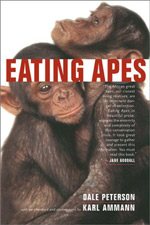Review of "Eating Apes"

Author(s): Dale Peterson
Published: May 2002, University of California Press, ISBN: 0520230906
 by James A. Huggins, Ph.D., University Professor & Director of the Hammons Center for Scientific Studies
by James A. Huggins, Ph.D., University Professor & Director of the Hammons Center for Scientific Studies
June 161, 2004 -
The consumption of apes, which must seem unthinkable to most of those who read this, represents only a small part of a world wide conservation problem. Countless threatened and endangered species are consumed for food and, driven by economics, are harvested illegally. Those that do not make the culinary habits of humans are in no better shape as they too perish from habitat destruction. However the great apes, the gorilla, the chimp, the bonobo, and the orangutan, are undeniably, because of their human-like characteristics, the “ambassador” species which best represent the slaughter and the loss of biodiversity that is occurring across the globe. These characteristics, including the ability to use tools, to laugh, to communicate with us through sign language, and to beg for life, illicit sympathy from the only species that can stop the destruction. Unfortunately, the only species that can turn things around is the perpetrator of the destruction. We have met the enemy and it is us.
The bushmeat enterprise has, due in part to a rapidly changing culture, modern weapons, depressed economy, Western exploitation of natural resources, and rapidly increasing human population, reached an unsustainable level. Tropical rain forests, the last remaining havens for terrestrial biodiversity and by nature the most opulent, are no longer safe from the self-indulgence of men. Indigenous peoples have for centuries lived off the land and have some undeniable right to do so. However, circumstances are now such that they, and we the people of earth, are on the verge of losing a precious gift that we will be powerless to retrieve. In fact, an extremely conservative estimate puts the rate of extinction across living organisms worldwide at 5000 species, each a repository of a unique genetic library, per year. This is due solely to human encroachment of one form or another and represents a rate that exceeds 10,000 times that of our modern human society. Despite the efforts of various governments, the consortiums of governments, world trade agreements, international laws and codes endangered species are still systematically being driven to extinction.
Peterson presents with great clarity the predicament in which we find ourselves. The economy of Sub-Saharan Africa is without doubt in need of help and Western logging concerns are bringing much needed economic benefits to the region but need and greed seem to have met in the tropical forests of Africa. Not surprising, money is apparently the main interest of big business and little is allowed to stand in the way of the exploitation of the environment. Logging interests, if not directly supporting the bushmeat trade though most do, have inadvertently provided the hunters with the roads they needed to rapidly transport meat to cities for sale. After all, stimulating the economy is for the good of the people and the national governments of the region can’t be too difficult for fear of economic consequences. Therefore little has been done by local governments to stop the transport and sale of illegally harvested game. This sale of illegally harvested game, quite frankly, is described by the people of these areas as an act of self preservation among peoples that face economic hardship on a daily basis. But there are participants in this drama beyond Western interests and indigenous peoples, biologists have long recognized the rape and pillage that proceeds across the African continent and various individuals and organizations have risen up in an attempt to stifle the loss of our genetic heritage. Realizing that any aid coming from this economically depressed continent would be too little too late, the appeal has been made to the citizenry of more developed nations to rescue the perishing. Consequently, other governments and world organizations have offered their expertise and help.
However, self-preservation, according to the author, can exist in a number of venues. Peterson blasts the “conservation organizations”, such as the World Wildlife Fund, National and International Wildlife Federations, and the Wildlife Conservation Society, for merely agreeing to clean up after the loggers rather than seeking real concessions from them. He even suggests that their overall effort has had the effect of aiding and abetting the problem. His premise is that these organizations must present a united front that indicates that the organization is doing something positive and making progress in the battle to save our planet. If this were not the case, it is surmised that memberships and readership would drop if, in fact, the rain forests were considered or believed a lost cause. He even blasts the Discovery and National Geographic channels for feeding the American public a diet of “feel-good conservation” that creates an “all is in good order” illusion that is anything but the truth. In his opinion, we seem to be attempting to place a band aid over a wound that has opened the jugular of the remaining bastions of biodiversity. While I recognize the complexity of the problem, I agree with Peterson. Too many species have already spilled the last of their life’s blood to accommodate the proclivities of man.
While we are crying about the endangerment of other species, it is really we, the human animal, who are taking it on the chin. While Peterson likely does not hold my belief concerning “nature” as a divine gift to thereby its responsible care a mandate of humans, he never-the-less sees their loss as also our loss. In addition, there is at least one way that this detestable assault launched on the apes has directly harmed man. To drive this example home, the fifth chapter digresses from the loss of habitat and biodiversity to address another and insidious fashion that the bushmeat trade has endangered the human species. Those who are unaware of the parallel history of SIV and HIV will find this section particularly intriguing. There is little doubt that the butchering of apes led to the infection of humans with SIV and the subsequent emergence of HIV. Attempts to alert the public to a danger that rose from this atrocity have largely gone unheard due to the conservation interest’s fear that chimps, and the associated conservation efforts, would suffer undue reprisal from the release of this information. Such is indeed a testimony to the varied interests that exist across the depth and breadth of biology and the inability of these factions to come together and reach a consensus over the totality of the discipline about what should be done, and in this case, and how humanity should respond.
Overcoming the problem of the rapid loss of unique life forms on earth is a complex one and Eating Apes artfully drives this point home. We simply should not let the gifts God has given us be squandered. As a species we have much to lose. Sustainability is the goal and I pray that it is not too late. In fact, we are told, and as Christians we believe, that all things are possible with Christ. As the caretaker species that God designated to this planet, and as followers of Christ, we are obligated to attempt to preserve His Creation. However with only 20% of the world’s original rain forest still in tact and other unique biomes equally suffering from man’s demand for more, someone must do something quick or the majority of those species God gave us to oversee will soon exist only in those “feel-good” documentaries produced for a disenfranchised public.

